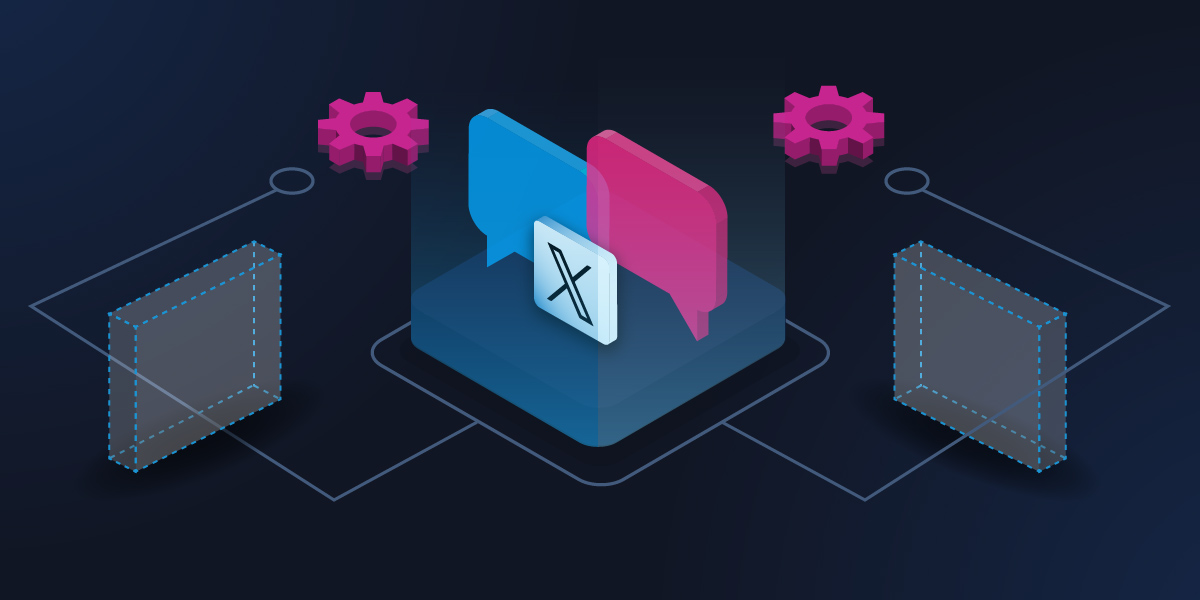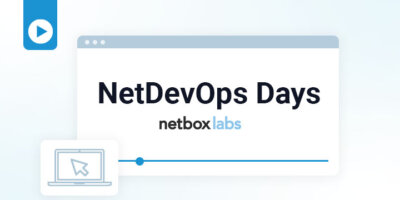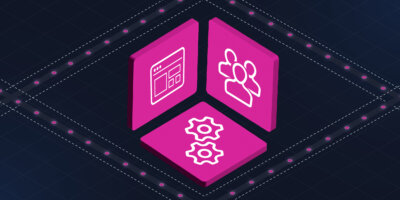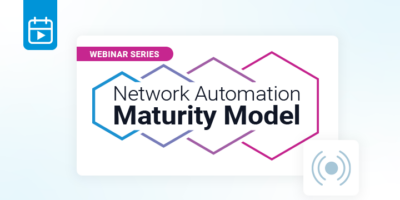This thread on X asked network engineers about the challenges holding back network automation adoption. The discussion showed that while some challenges are inherent, many of the answers were rooted in misconceptions that could be slowing teams down unnecessarily.
The thread opened up with this question from Jordan Villareal:
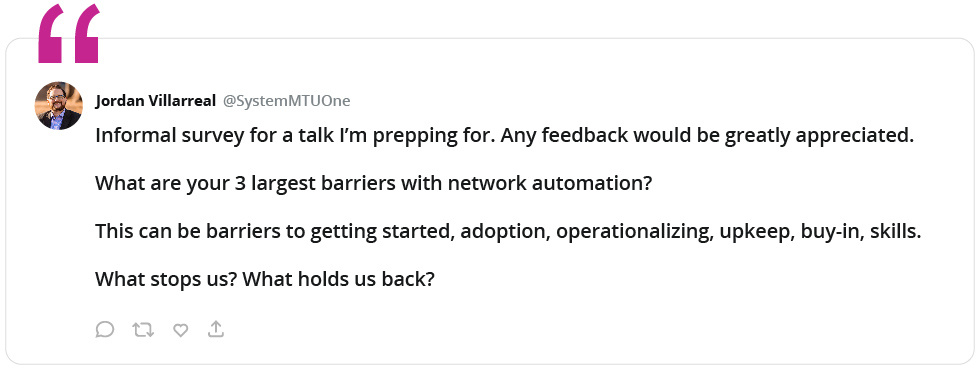
You can scroll through every answer here. Below, I’ve pulled just a couple answers that had higher engagement and feel like they’re representative of the main barriers people were bringing up.
Response #1: Misconceptions & the Shrinking Skills Gap
This answer, courtesy of John Capobianco, clearly comes from someone who’s had success with automation and wants to combat some of the common barriers.
All three of his points share the fact that there’s a gap between expectations and reality. While teams may think automation is too difficult, or they may be limiting their automation reach to configuration management alone, they have the ability to do more with a different strategy.
The shrinking skills gap is an especially important point. Network engineers have embraced automation technologies, especially Python, and “script” automations are extremely common for configuration changes. As organizations look to adopt new platforms to extend automation beyond configuration, the best solutions will be the ones that can make use of existing automation work in Python, Ansible, and Terraform.
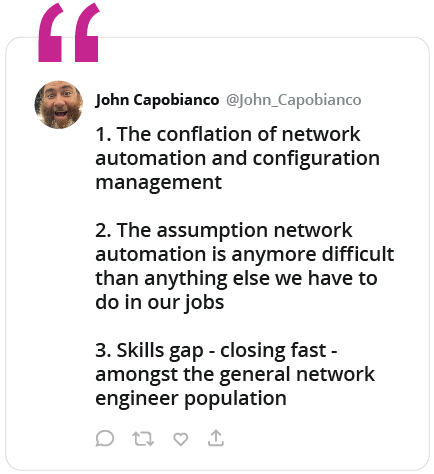
Itential’s Solution
IAG (Itential Automation Gateway) is a platform that can onboard any automation written in any language and attach API endpoints to it. Different network teams in different domains naturally gravitate toward different tools for automation because of their own unique environments. IAG helps secure and share all of these different automations. This approach also allows users of the Itential Automation Platform to leverage these Python, Ansible, and Terraform automations in an API-driven network orchestration workflow.
Response #2: Network “Snowflakes”
Here, Andree Toonk discusses a key challenge inherent to network automation. It’s fair to say other areas of IT like server and compute have been ahead of networking in terms of automation due to the ability to standardize components and configurations.
In networking, however, global standardization shouldn’t be considered as a prerequisite to automation because a) physical, on-premises networks inherently have a lot of complexity and b) hybrid, multi-cloud strategies are proving more common than any other approaches to cloud, which are inherently different.
With the right tools, it is possible to define and enforce different standards across different environments while you automate network changes, so standards can be maintained in a way that suits the network while also ensuring the complexity of the network doesn’t slow down automation progress. Like Jordan mentions in his reply, the answer comes in part with a multi-tool approach, where network teams leverage best-fit tooling between different domains and device types for automation of single tasks. As teams mature in this approach, they will evolve toward a network orchestration strategy.
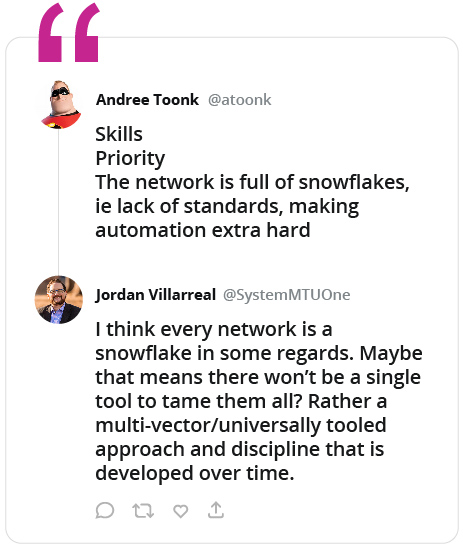
Orchestration is a kind of automation of automations, stitching together individual automated tasks to create a workflow that can execute a change process end-to-end. Successfully implementing orchestration starts with adopting a platform that can onboard automations across all the different tools in use, integrate with network and IT systems, and allow orchestration across multiple network domains.
Itential’s Solution
As mentioned above, IAG can onboard, manage, and execute automations from any domain. Then, the Itential Automation Platform’s integrated workflow building capabilities enable users to easily orchestrate change processes across multiple domains, stitching together automated network changes with API calls to external systems allowing an entire network service to be delivered as an end-to-end outcome.
In addition, Itential provides compliance tools to define standards for network and cloud configurations in a dynamic way that fits the hybrid, complex nature of modern networks. These features can be automated and included in an orchestrated workflow to ensure that all automated network changes, no matter the complexity, are consistent with an organization’s defined standards.
Response #3: How to Deliver Automations for Consumption
Fear is a big point, but it’s something teams can solve. You can combat fear with confidence. Network teams that are empowered with the tools and the ability to build automations according to organizational procedures—and who are able to test those automations and validate changes—will quickly build organizational confidence in their automation strategy.
The third point in this answer from Ioannis Theodoridis is important to focus on as well. Once you’ve built a network service that can be automated from start to finish, the next question is, how do people consume it? Teams might not prioritize this at first, but it’s crucial.
Self-service involves several considerations. First, network services must be automated end-to-end, otherwise manual intervention will be required for service delivery. Second, security and access control must be enforced while delivering network services to distributed end users. And third, the consumers of network services must be able to consume those services in an efficient way without disrupting their usual workflows.
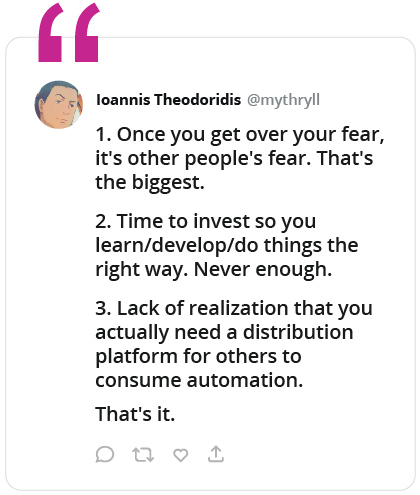
Itential’s Solution
Our platform exposes its API for consumption by other systems northbound, creating a kind of unified network API that can be called to run any network service published by an organization’s network team. Itential can leverage all the disparate components of the network and then expose a single end-to-end workflow for ServiceNow users, ServiceNow developers, DevOps teams using a CI/CD pipeline, and other automated systems to run by making a simple API call. With this approach, teams can deliver network services with the same instant ease of use as public cloud services, while ensuring they can maintain security, compliance, and access control standards by building testing and validations into their Itential workflows.
Breaking out of misconceptions helps teams and individuals refine their approach to automation and make the right technology choices — enabling you to expand network automation from configurations to entire change processes, orchestrate across all network domains, and deliver services for self-serve consumption by end users like IT application teams.
You can dive into our Network Automation and Orchestration Maturity Model here to learn more about how teams and organizations progress and evolve, from adopting automation to enabling self-service networking at scale.

